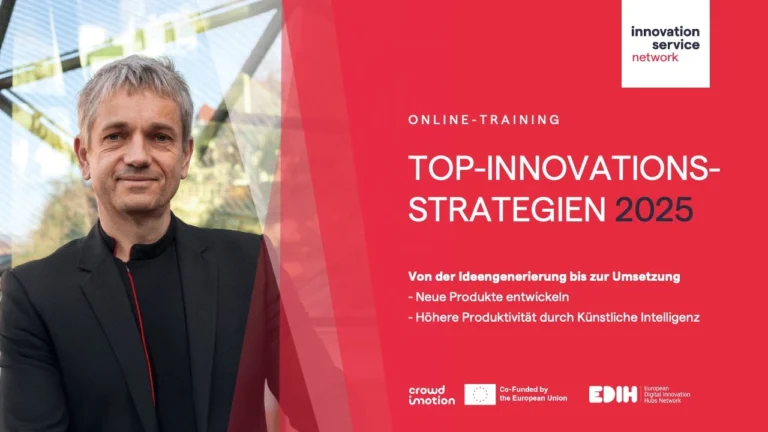

In 10 steps to an innovative company
"You only fly as far as you already are in your head".
Jens Weisflog, former ski jumper
Especially in team sports, where "team spirit" is the basis for success, I see many parallels: Just as innovation in companies affects EVERYONE, a team can only be successful if everyone is fully committed and energized. And there are key roles: e.g. captain and coach!
These key roles for innovation in companies are played by the top management and in particular by the managing directors, in family businesses often also by the owners. Many focal points in companies are already "matters for the boss," e.g., finance, human resources, customer acquisition. Recently, digitalization, sustainability and the circular economy have been added to this list. All of the aforementioned topics have an impact on the cross-cutting topic of innovation or can be shaped with professional innovation management. In addition to the innovation leadership role of top management, the role of "Innovation Manager" is particularly important, ideally as the "captain" of a multi-member innovation team.
In practice, however, things often look quite different. Here are two examples:
Example 1: A CEO of a medium-sized company sees the need for innovation in the company and starts an initial initiative on his own initiative. With an e-mail to all employees comes the invitation: "Please send me your ideas and suggestions for improvement". Within a few days, more than 100 e-mails arrive in the CEO's inbox. They range from two-liners to detailed descriptions of more than 25 pages. Conclusion: The process stops at this point due to a lack of resources and the chances of a positive second attempt are significantly reduced.
Example 2: A large, management-led company appoints a new CEO. He gets status reports from all departments and locations. The R&D department management receives the question: "And what are we doing about innovation? Please provide me with a concept in 6 weeks". Result: This "delegation" leads to excessive demands on a single person, because up to now "innovation" has not been a topic in the R&D department. The department management sees the opportunity of the new topic and wants to be part of it, but at the same time the lack of know-how leads to uncertainty.
Innovation leaders in their respective industries are often led by personalities who radiate innovation and authentically back it up with activities and decisions. Steve Jobs' legendary product launches quickly come to mind (which, by the way, he trained for weeks, with coaches). But innovation leaders must also be able to stand in front of their staff in order to communicate the strategic direction, the goals and, above all, the spirit of innovation to ALL in an unmistakable way.
Corporate management has the power to allocate resources to innovation projects and to motivate employees to contribute ideas and promote the implementation of new ideas. Innovation thus also has a massive influence on the company's culture for change and renewal. Important: Every innovation process needs sufficient resources to get from a possibly critical state A to a state B. The state B should in any case be a critical one. State B should in any case be a desirable better state! As an innovation leader and CEO, the following important topics should be considered:
Finally, a positive example of innovation leadership courtesy of RWTÜV management:
Case study RWTÜV, Germany: The Managing Board used the 150th anniversary of RWTÜV as an opportunity to establish a Group-wide innovation management system from within the Group holding company. The goal was to network all employees worldwide for the first time for joint work on future projects in order to utilize the creative diversity of all sub-companies. It quickly became apparent that many employees were already waiting to contribute their ideas. At the same time, creative minds became visible of which one did not know that they were sitting on valuable knowledge. The first ideas are already being implemented and at the same time further organizational measures are being taken. Interested parties can find more details in an interview with the CEO Thomas Biedermann.
Is innovation already a top priority in your company? How do you rate the culture of innovation and the courage to break new ground in your company? How much budget will there be for innovation in your company next year?
I look forward to feedback and wish you a relaxing and creative Sunday!
Reinhard Willfort, Innovation Doctor





